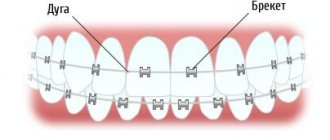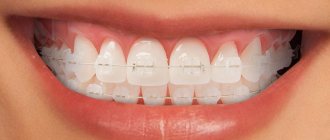To correct bites in orthodontics, two types of braces are used – vestibular and lingual. The first ones are installed on the outside of the dentition, the second ones on the inside. Thanks to this installation, lingual braces allow you to correct your bite without anyone noticing. In our clinic you can undergo orthodontic treatment using lingual braces. We use braces from the brands Incognito, InOvation L, WIN, Stb, 2D. An experienced orthodontist will select the appropriate braces system for your case.
The principle of operation of braces
A brace system is a mechanical device designed to move one or more teeth in a given direction. Translated from English, bracket is a bracket. It is the bracket-like element that represents one of the basic parts of the bracket system.
Structurally, the correction device consists of the following parts:
- plates (braces) attached with special glue to the inner or outer side of the dentition;
- power arch, fixed using fasteners on bracket plates.
The orthodontic clasp is given a configuration determined by the characteristics of a particular clinical situation. It is then inserted into the slots of the braces. The arch has “shape memory”, so it tends to return to its initial position, thereby creating pressure on the dental elements.
The principle of operation of correction devices is simple, like all ingenious things: braces fixed to the tooth enamel transfer to them the pressure force of the orthodontic clasp. This process is continuous, so dental units begin to shift along a given vector over time. The intensity of pressure on each unit is calculated by the orthodontist using a computer program. If it is required that the element moves in the longitudinal direction, then the bracket is fixed to its middle. If the tooth needs to be rotated, then the plate is attached closer to its edge. Each of the mini-locks has its own angle of inclination, depending on the pattern of the required movement.
The ability of teeth to move is explained by the peculiarity of their attachment in the alveolar sockets. Dental units below the coronal part are covered with periodontal tissue, which is fibrous connective tissue. It is she who holds the tooth roots in the alveoli. The basis of the periodontium is the periodontal ligaments; they connect the cement of the dental element with the alveolar matrix. Periodontal ligaments are not static; they contract and stretch to form osteoblasts (young bone cells) and osteoclasts (bone-removing cells). The power wire, through braces, presses on the tooth, causing these ligaments to stretch in one direction and compress in the other.
Types of braces for installation on the inside of teeth
Depending on the presence of a particular pathology of the dental system in the patient and the features of its correction, lingual braces systems are distinguished for the upper and lower jaws, for one jaw and partial lingual braces. Brands of individual manufacturers are also distinguished.
According to the method of fastening they are divided into:
- ligature - a metal arc is attached to each lock with an elastic ring; these designs require regular correction by the dentist of the degree of tension of the arch, since it can change as the teeth move in the right direction;
- non-ligating (self-ligating) - a more modern type of fastening, where the arch is secured to the clasps with special caps; the tension of the arc is set initially and does not change, so you need to visit the dentist less often.
Lingual braces for one jaw
Sometimes, to solve the problem, it is enough to install lingual braces on one jaw. Such a correction is possible if:
- interdental gaps in the anterior part of the dentition with correct closure of the lateral teeth;
- moderate crowding of teeth in the dentition;
- easy rotation of several teeth in the dentition.
Partial lingual braces
Partial internal braces
Installation of partial structures is possible if there is pathology in one specific place in the dentition. For example, if several front teeth are incorrectly positioned or if there is a diastema (significant interdental gap) in this place. Sometimes partial internal braces are installed on the front teeth of the upper jaw, visible when smiling, and external vestibular structures are installed on the rest.
Lingual braces for one jaw and partial structures are much cheaper than full braces. But the patient himself cannot decide on their installation. Treatment with lingual braces and selection of their type is the responsibility of the orthodontist.
Types of internal braces by manufacturer
Lingual braces are manufactured by numerous manufacturers from different materials using different technologies. The world's most popular brands are produced mainly in Germany and the USA.
Incognito (TOP-Service, Germany)
Lingual braces Incognito
This is the most popular model of the traditional ligature (the arch is attached to the clasps with elastic rings) type made of gold hypoallergenic alloy. The model has been on the Russian market for more than 15 years. Incognito's clasps are flat, which reduces the period of getting used to the design after its installation and makes wearing it hassle-free: they do not injure surrounding tissues and do not interfere too much with the pronunciation of sounds. Incognito lingual braces are made according to an individual impression in one of the best laboratories in the world, Top Service. The Incognito system is installed for mild to moderate malocclusions, crowded and uneven teeth, and large interdental spaces.
WIN (DW Lingual Systems GmbH, Germany)
Win braces
Improved mini ligature type win model with very small flat clasps made of chromium and cobalt alloys. Does not contain precious metals, therefore cheaper than the Incognito model. The new design allows for an individual adjustment to the patient's dentition. Win lingual braces are very comfortable to wear: they are almost invisible, do not scratch the tongue and almost do not interfere with speech. Effective for disorders of the dental system of moderate complexity.
2D (Forestadent, Germany)
Self-ligating internal braces 2D Forestadent
A flat, smooth model made of hypoallergenic alloys of base metals of a self-ligating type (without the use of ligatures). Its peculiarity is the wearing comfort associated with sufficient space for tongue movement. Speech may be impaired only during the adaptation period, then it is completely restored. But lingual braces of this model are not suitable for patients with short tooth crowns.
In-Ovation L (Dentsply GAC, USA)
Self-ligating braces In-Ovation L
Self-ligating construction made of hypoallergenic nickel-cobalt alloy. The clasps are small, smooth, and do not irritate the tissues of the oral cavity. It is easily installed in the patient’s mouth and can also be easily removed and put on by the dentist if necessary. It is impossible to change the degree of influence of the metal arch on the dentition in this design; it is set initially, so the correction occurs gently, allowing you to slowly and painlessly obtain the desired effect. This lingual brace system is especially effective in straightening teeth in the dentition.
STb (Ormco, USA)
Ormco STb internal braces
Metal braces of ligature type. Made from hypoallergenic nickel and cobalt alloy. The archwire and clasps of the standard type require sufficient height of the dental crowns and jaw width. The clasps are secured to the teeth using a special computer program. Suitable for correcting mild to moderate bites, as well as for straightening teeth. The advantage of the model is its relatively low cost.
Read about other types of braces here.
Types of bracket system designs
The classification of bracket structures depends on the selected classification feature:
- material of manufacture;
- fastening method;
- positioning.
Next, let's look at species differentiation in a little more detail.
Depending on the material from which the plates are made, bracket systems are:
- metal ones are reliable, but are significantly inferior to other mechanisms in aesthetic terms. As a rule, they are made of medical steel, sometimes with gold plating. Another option is titanium correction products. Titanium is a bioinert alloy, therefore it is recommended for people who are allergic to other metals;
- ceramic - the color of the plates practically matches the shade of the enamel, so they are practically invisible in the oral cavity;
- plastic - have good aesthetics, but wear out very quickly and become stained under the influence of food and smoking;
- sapphire – transparent, invisible, superior in strength to ceramic devices;
- combined - different materials are used in different areas of the mechanism. For example, in the smile zone there are sapphires, in the chewing zone there is metal.
Orthodontic equipment differs in the method of attachment. The classification is as follows:
- ligature – in these products the driving arch is attached to bracket plates using ligatures. These are special fastening parts - elastic rings or metal wires;
- non-ligature - here the guide clasp is secured by means of movable clamps (clips, latches, latches).
Correction systems differ from each other in their positioning location:
- vestibular - attached to the outside of the dental line. They are the traditional and most common type of orthodontic equipment.
- lingual - fixed on the inside of the teeth from the side of the tongue. Hence the name, “lingua” (lingua) translated from Latin means “language”.
The type of braces for the course of treatment is selected by the orthodontist at our clinic depending on the characteristics of each specific clinical case.
How do lingual braces differ from conventional braces?
The main difference between lingual equipment is the location zone on the tongue side. This arrangement allows you to visually hide the correction system from prying eyes. This is a huge advantage for those who would prefer to keep the corrective course of therapy a secret. Therefore, this type of braces is especially popular among media figures and shy people.
Lingual devices are made individually for each patient, depending on the structural features of his jaw apparatus, the type and complexity of the pathology. For such orthodontic equipment, only metal is used. This makes the leveling efforts more intense.
Structurally, lingual orthodontic devices are similar to vestibular ones. They are non-removable; the main elements of the system are also brackets fixed to the surface of the enamel and a power arc.
Installation of lingual braces requires special skills from the orthodontist. The specialists of our clinic have the appropriate qualifications and provide corrective treatment at a high professional level.
Peculiarities
Lingual braces are invisible orthodontic treatment mechanisms that are attached to the inside of the teeth. They are otherwise called invisible.
Even from the name it is clear that they are fixed from the side of the tongue (Lingua - language).
The use of invisible braces is especially popular among pop stars, public figures, politicians and those whose work is inextricably linked with constant communication.
The mechanism of action of such systems is exactly the same as that of classical models. Lingual options apply gradual pressure on the dentition, forcing individual units to occupy the desired position in the oral cavity.
Key differences
There are several main distinctive features of lingual braces. They are quite difficult to install. This is due to the fact that there are a large number of grooves, bumps and irregularities on the inside of the teeth, which creates certain problems during the fastening process. The doctor must carefully study the features of the shape of each tooth, only then can he determine the exact structure and appearance of each individual lock.
It is also worth noting that the arc of lingual systems is not the same as that of conventional ones. It has a more complex geometry, since it cannot be located at the same smooth angle as the standard one (on the outside of the row).
Lingual braces are always made for a specific patient, taking into account the structural features of his jaw. The most advanced computer technologies and sophisticated equipment are used in the production process. The process takes up to several weeks.
In addition, to avoid allergies to the materials used, locks can be made from special metals, such as gold. All these nuances affect the final cost of manufacturing and installing lingual braces. Not everyone can afford this treatment option.
The clasps of lingual braces are small in size, they are not so voluminous and do not have sharp corners. This is necessary for quick adaptation and prevention of discomfort.
Due to their smaller size, arches act a little slower, because they have less pressure on the teeth. This is why treatment may take longer compared to using classical types of systems.
Advantages and disadvantages of lingual braces
There is no panacea for malocclusion. Therefore, lingual systems, like other orthodontic structures, have their advantages and disadvantages. Carrying out a comparative analysis between different types of leveling mechanisms, we can conclude that there are still more advantages than disadvantages.
Advantages of lingual braces:
- invisibility to outsiders. This preserves the patient’s state of psychological comfort, which is very important during a long course of corrective therapy;
- preservation of facial aesthetics (profile of lips, cheeks, nasolabial area);
- individual computer 3-D modeling, which allows the orthodontist to predict the course of treatment, make adjustments to the process if necessary, and the patient to visually see the result of correcting the occlusion before the process begins;
- minimizing the risk of developing caries on the vestibular part of the enamel layer;
- inability to injure the inner surface of the cheeks and lips;
- increased strength of the metal structure;
- hypoallergenic alloys from which correction products are made;
- the ability to correct a deep bite;
- minimal risk (in comparison with standard devices) of operation when engaging in active, especially contact sports.
Flaws:
- high price due to individual production and complexity of installation;
- longer adaptation period (up to a month);
- deterioration of diction and articulation, possibility of injury to the tongue, increased salivation, sensation of a foreign object in the mouth and pain during the adaptation period;
- increase in the duration of the correction period in comparison with vestibular samples;
- difficult hygienic care.
Do you really need lingual braces as your doctor advises?
Are you ready to carry this pile of iron in the form of lingual braces in your mouth for the entire duration of treatment (a year or two)?
Rub your tongue against them, polish them until they shine, eliminating pieces of food? Braces are uncomfortable and not aesthetically pleasing. Yes, aligners can’t fix everything. But you can have a free consultation with our orthodontists and understand - what if your case can be perfectly cured with aligners? If aligners can do it, then why subject yourself to self-torture with braces? So, we offer a FREE consultation. The Star Smile company operates in more than 70 cities of Russia and will be able to offer you competent consultation with an orthodontist in your city.
Take the first step towards comfortable treatment
Indications and contraindications for the installation of lingual structures
Bite correction is a therapeutic medical intervention, and therefore is carried out only if there are appropriate indications:
- congenital or acquired anomaly of occlusion;
- incorrect position of individual elements of the dental row;
- slot spaces;
- concomitant violation of enamel mineralization.
To the above we can add the patient’s persistent desire to hide the process of corrective therapy.
Sometimes it is impossible to correct anomalies of the dentofacial complex using braces. Contraindications to installation can be conditional, i.e., a course of correction can be started when the reasons for the prohibition are eliminated, and unconditional, which are a categorical taboo.
Conditional contraindications:
- age up to 12 years, i.e., until the dentofacial apparatus is fully formed;
- pregnancy and breastfeeding;
- gum diseases (periodontitis, gingivitis, periodontal disease);
- caries, presence of hard deposits;
- the impossibility of careful hygienic care (for example, on a long journey away from the benefits of civilization).
Unconditional:
- too narrow jaw arch;
- excessively low coronal part;
- excessive torsion of dental units (more than 6 mm);
- presence of implants;
- diseases of the temporomandibular joints;
- bruxism (unconscious grinding of teeth);
- severe mental illness (for example, epilepsy);
- physical inability to perform oral hygiene;
- osteoporosis;
- diabetes;
- serious problems with the cardiovascular system;
- tuberculosis;
- oncology;
- HIV.
Indications and contraindications for adjustments using lingual brace systems in our clinic are identified by an orthodontist during a consultation.
Motivation for orthodontic treatment is different for men and women
Regular surveys of adult patients who are considering certain methods of correcting their bite show that men and women motivate themselves differently against braces. But the basis for refusing treatment with lingual braces is their two disadvantages - discomfort
and
price
.
Men speak directly about the discomfort of braces: “Am I a boy, or what?”
Women reduce the problem of wearing braces to a psychological level, preferring aligners:
Model range of lingual braces
There are several options for lingual appliances that are used by dentists around the world. But there are two models that have surpassed their rivals in popularity due to their optimized flat configuration and efficiency of use. These are examples of the Win and Incognito trademarks, developed by Dr. Dirk Wichmann. They are produced by DW Lingual Systems Corporation, whose main production facilities are located in Germany.
Individual braces are made in a German laboratory for each individual client. In this case, CAD/CAM technology is used based on impressions and measurements taken by a doctor. This means that a virtual sample of a future product is programmed on a computer, and then the finished product is manufactured. All production is carried out automatically, i.e. without human intervention.
Production and delivery of orthodontic devices from Germany to Russia takes about 4 – 6 weeks. But the long wait is fully compensated by the ideal fit of the bracket plates, accurate calculation of the required pressure force and a proven scheme for adjusting the occlusion of a particular patient.
Features of the Incognito model
The Incognito bracket system is ligature. Material: gold alloy. Gold is a bioinert material, so it is suitable for people who have an allergic reaction to other metals.
The flat design of the plates allows you to reduce the adaptation period to 2 weeks and makes wearing the corrective device more comfortable. Bracket equipment of the Incognito brand is effective in correcting any type of minor and moderate malocclusion, crowding and unevenness of the dental row, and eliminating gaps between dental units.
Benefits of treatment at ROOTT
RUTT Dentistry provides services for correcting bites and straightening teeth using the latest technologies and the latest generation braces. The therapeutic regimen and orthodontic apparatus are selected according to the clinical situation. The price for installing braces is set on a turnkey basis and remains unchanged during the course of treatment. It is quite possible to install lingual braces inexpensively. The STb or Suresmile models are cheaper than the Incognito or In-Ovation L systems, since these are template designs that are adapted to the patient, and are not developed individually. This has a minimal effect on the effectiveness of treatment (the time of correction and adaptation increases slightly).
Distinctive features of Win
The Win orthodontic system is a more advanced Incognito model. This development has a minimally flat profile of the fastening pads, which increases the ease of their use, and miniature locks for fastening the guide clasp. Designed to correct pathologies of any complexity.
“VIN” is made from an alloy of chromium and cobalt powder, without containing precious metals, this makes the equipment more economically accessible.
Stages of preparation and installation of lingual structures
Proper preparation of the oral cavity is an important part of effective treatment. The presence of foci of infection, pathogenic microflora during caries or in dental plaque can provoke an inflammatory process in periodontal tissues. Therefore, before starting a long course of corrective therapy, a complete sanitation of the oral cavity is carried out:
- treatment of caries, pulpitis, periodontitis and periodontal diseases;
- professional comprehensive cleaning. The complex includes cleaning the enamel from hard deposits with an ultrasonic scaler, and using the Air Flow hardware method to remove soft deposits.
Then the orthodontist at our clinic carries out a complete diagnosis of the condition of the patient’s dental apparatus using computer and X-ray equipment. As a result, obtaining tomographic and radiographic images for analysis - an orthopantomogram.
The next step is to make impressions of both jaws and fill out a unified order form. All received materials are sent to a production laboratory in Germany. The manufacturing process consists of several stages:
- creation of an installation sample of dental rows using laser scanning of impressions;
- programming intermediate models to illustrate the progress of the correction course;
- calculation of the parameters of each individual bracket and the coordinates of its positioning on the tooth surface;
- calculation of arc parameters;
- creation of wax samples of all parts, and on their basis - bracket systems from real materials;
- grinding and polishing;
- molding a silicone transport tray.
After the finished braces are delivered from the manufacturer to our dental center, the patient is called to the clinic for installation.
Fixation of the plates onto the prepared enamel (washed, dried and etched with a reagent to improve adhesion) is performed using a transport tray in which the bracket system is delivered. Without removing the equipment from the tray, mounting glue is applied to the plates. Then the mouthguard is placed on the dentition and dried with a special lamp for polymerization. After this, an orthodontic arch is attached to the fixed plates. This completes the installation.
Duration of treatment and frequency of visits
The stage of direct correctional therapy is a long period. Its duration directly depends on the characteristics of the patient’s bone tissue, the complexity of the clinical case, as well as the age of the patient. The frequency of visits is determined by the doctor at our center on an individual basis. On average, a corrective course lasts from 12 to 24 months, and the frequency of visits is once every 2 to 3 months.
You should also remember about the final stage, which consolidates the achieved result. After removing the braces, it is necessary to wear a retention device. Without this step, the teeth may return to their previous positions.
Installation of braces
First, the orthodontist conducts a full diagnosis. At this stage, the type of defect and the degree of its severity are determined. If necessary, the orthodontist will prescribe an instrumental examination - x-ray, orthopantomogram, CT scan. Based on the examination results, the doctor will develop a treatment plan and select the optimal braces system.
Before installing braces, it is necessary to cure dental diseases. Immediately before installation, professional teeth cleaning, plaque and tartar removal are performed.
The installation takes place in several stages:
- Treatment of dental crowns. They are coated with a special composition that improves adhesion. This composition also helps strengthen the enamel, as it contains minerals.
- Fixation of braces. They are secured on the lingual side with dental cement. An arch is fixed to the brace locks.
The installation of braces takes about 2 hours. After this, you will need to regularly visit the orthodontist for examination and correction. The schedule of visits is made individually, but on average you need to visit a doctor once every one to two months. The duration of treatment depends on the complexity of the pathology; it can take 1.5-2 years.
How to care for lingual braces
Oral care throughout the course of corrective therapy is an extremely important point. It is important to maintain hygiene and follow a certain diet.
Do not use:
- solid foods, nuts and seeds;
- sticky substances such as toffee and dried fruit;
- excessively hot or cold food;
- drinks containing pigments (tea, coffee, cherry juice, red wine).
You should not chew chewing gum; food should be cut into small pieces.
To avoid caries and more serious diseases, the following hygiene rules are recommended when wearing lingual appliances:
- cleansing the mouth after every meal, regardless of its size. In the absence of special devices (for example, after lunch at work), the mouth should be rinsed thoroughly with water;
- home care must necessarily include cleaning with a special V-shaped orthodontic brush, a brush for braces, an irrigator (a device that cleans teeth with a stream of water), floss (dental floss);
- Professional comprehensive cleaning of the oral cavity in our clinic at least once every six months.
Only with strict adherence to the listed tips and recommendations of the attending physician will corrective therapy be effective and give the expected results.
Features of care
During orthodontic treatment, high-quality and regular hygienic care should be carried out. Braces create retention points to retain food debris, so brushing or rinsing the mouth must be done after every meal. There are various means for hygiene: brushes with a recess, with a specially shaped head, brushes, brushes, special pastes, monotuft brushes, irrigators, etc. Experts recommend using a selected brush and paste, rinsing your mouth with mouthwash throughout the day, and cleaning hard-to-reach areas with an irrigator in the evening.
Cost of treatment
The cost of correcting a bite using linval braces is significantly higher than the cost of correcting a bite using vestibular structures. This is due to the fact that the production of corrective systems occurs abroad individually for a particular patient.
The cost of treatment at our dental center includes:
- orthodontic bracket system and its fixation;
- regular visits to the doctor to activate the equipment;
- removal of braces;
- creation of retention structures.
For the convenience of our patients, we provide the opportunity to pay not with a one-time payment, but in installments:
- INCOGNITO - total cost is 350,000 rubles. on 1 jaw, 420,000 on both.
Installment plan: on one jaw - 150,000 first payment, then - 20 months of 10,000 rubles. For two - 200,000 initial payment, then - 20 months of 11,000 rubles.
- WIN – total cost – 230,000 rubles. on 1 jaw, 370,000 on both.
Installment plan: on one jaw – 60,000 initial payment, then – 20 months of 8,500 rubles. For two – 120,000 first payment, then – 20 months of 12,500 rubles each.
An additional bonus is the provision of a family discount if several family members use the services of our clinic.
About the price of bite correction with lingual braces
The price of bite correction with lingual braces will largely depend on the type of structure and its manufacturer. Therefore, it is impossible to name the exact cost of treatment in absentia - you need to visit an orthodontist, undergo diagnostics, decide on the type of braces, and then the specialist will draw up for you a detailed plan of the treatment course, which will indicate the exact and final prices for all the necessary procedures.
The average cost of bite correction with lingual braces in Moscow ranges from 100 to 400 thousand rubles. It is worth keeping in mind that the indicated amount does not include the costs of scheduled examinations at the orthodontist’s office during the course of treatment, as well as the cost of removing braces and subsequent installation of retainers, the wearing of which secures the achieved positive result.
Bite correction at the “Smile” clinic – reliable, high-quality, comfortable
The doctors at our center are high-level professionals. They regularly improve their qualifications in Russia and the European Union, which allows them to keep abreast of innovations in dentistry and introduce innovative developments into their practice. We take into account the comments and wishes of our patients, this gives us the opportunity to become better and correspond to the status of an advanced dental center.
The specialists of the “Smile” clinic offer effective orthodontic therapy using the latest lingual brace systems. Masterly mastery of correction technologies allows our doctors to cope with any pathologies of the dentofacial apparatus, regardless of the degree of complexity of the clinical case.
Dentistry “Smile” has two branches located in Moscow within easy reach of public transport stops:
- branch next to the Alekseevskaya metro station (VDNKh area and Mira Avenue): st. 3rd Mytishchinskaya, 3, building 2;
- branch near the Shelepikha metro station. Address: Shelepikhinskaya embankment, 34, building 1.
You can make an appointment for a consultation by phone or on our center’s website using the “Book online” or “Order a call” options.
Orthodontic dentists can make your teeth healthy and your smile attractive. Come to us for a beautiful smile!










